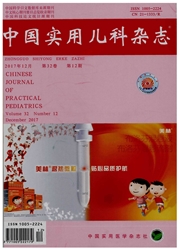

 中文摘要:
中文摘要:
目的探索孤独症儿童共情和系统化特质、表情识别特征及两者之间关系。方法2013年1月至2014年12月招募6~11岁孤独症儿童至中山大学儿童青少年体质与行为研究中心进行评估,年龄、性别匹配的孤独症儿童和正常儿童各2l例,使用共情/系统化问卷和“中国人物静态表情图”对两组儿童进行测试,比较其共情维度分(EQ)、系统化维度分(SQ)、该量表总分(EQ—SQ)、以及命名和匹配7种基本表情的正确率。结果(1)孤独症组儿童的EQ[(20.3±9.5)vs(30.90±9.8)]、SQ[(17.7±5.4)vs(30.9±9.8)]以及EQ—SQ[(37.9±10.9)vs(57.2±17,7)]均低于正常对照组,差异均有统计学意义(P〈0.05)。(2)孤独症组儿童命名中性、吃惊和讨厌3种表情的正确率低于正常儿童组(均P〈0.05),命名其余表情的正确率之间差异无统计学意义。孤独症组儿童匹配中性、高兴、害怕、讨厌表情的正确率低于正常组儿童,差异均有统计学意义(P〈0.05),匹配其余表情的正确率之间差异无统计学意义。(3)正常组儿童命名表情的正确率与EQ、SQ均呈正相关(r分别为0.42、0.62,均P〈0.05),而孤独症组表情命名正确率仅与EQ得分呈正相关(r=0.87,P〈0.001)。结论孤独症儿童共情和系统化能力不足、部分基本表情识别能力低,其表情识别能力不足可能与共情特质有关,而与系统化特质无关。
 英文摘要:
英文摘要:
Objective To explore the characteristics of empathy-systematic ability and facial expression recognition in children with autism, and to explore the relationship between these two abilities. Methods Twenty-one children (6 - 11 years old) who met DSM-IV criteria for autism and 21 children with typical development of same gender and age were recruited. The Empathizing/Systemizing Quotient, child version (EQ-SQ) was used to assess children's empathysystematic ability and the higher scores indicated the better ability. The facial expression recognition test was carried out with the static expressions figure of Chinese characters. The accurate rates of naming or matching emotion were used as the evaluation index of facial expression recognition test and the higher accurate rate indicated the higher level of facial expression recognition. Results (1)Children in autism group had lower scores of EQ [ (20.3±9.5)vs. (30.90±9.8) ], SQ[ (17.7± 5.4)vs. (30.9±9.8) ]and total EQ-SQ [ (37.9±10.9)vs.(57.2±17.7) ] compared with the children in typical development (TD) group. (2) The accurate rate of naming the "neutral", "surprised" and "disgusted" facial expression were lower in autism group than those in TD group (P 〈 0.05), while there was no significant statistical difference be- tween two groups concerning other facial expressions. The accurate rate of matching the "neutral", "happy", "frightened" and"disgusted'facial expression were lower in autism group than those in TD group (P 〈 0.05), while there was no signifi- cant difference between two groups for matching other facial expressions. (3)In TD group,the total accurate rate of nam- ing facial expression was positively correlated with the scores of EQ and SQ (r=0.42 for EQ, r=0.62 for SQ; P 〈 0.05),while there was only positive correlation between accu- rate rate of naming facial expression and the scores of EQ in autism groupr (r=0.87, P 〈 0.001). Conclusion This st
 关于张玲:
关于张玲:
 关于金宇:
关于金宇:
 同期刊论文项目
同期刊论文项目
 同项目期刊论文
同项目期刊论文
 期刊信息
期刊信息
